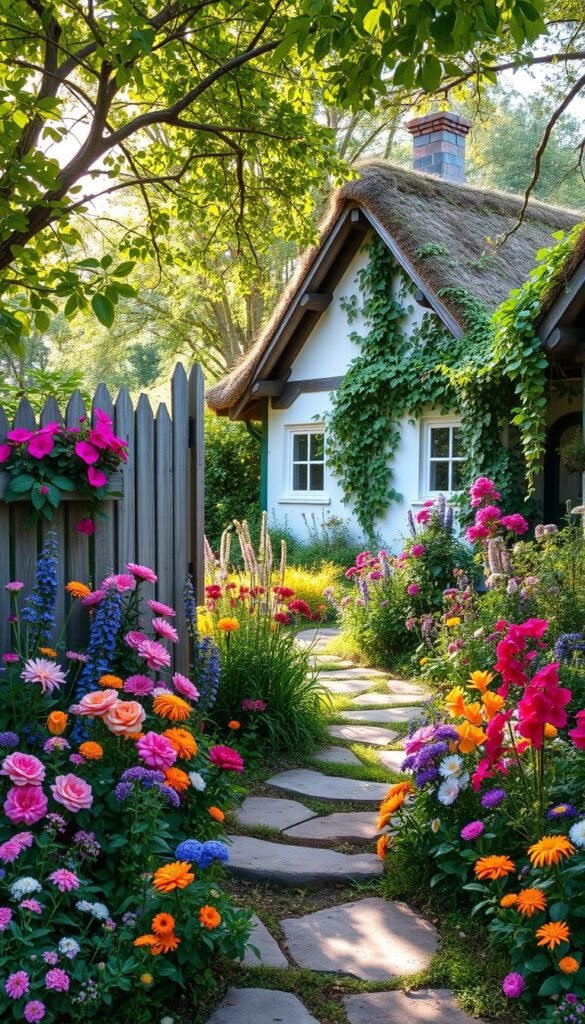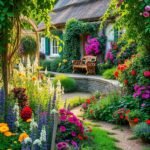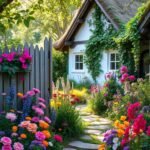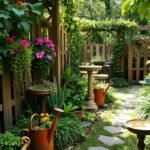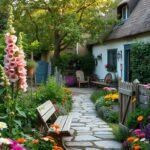Imagine stepping into a space where time slows and nature wraps you in color and fragrance. What if your current landscape could become a living storybook filled with romantic blooms and whispering greenery? This guide reveals how to craft a whimsical retreat that blends centuries-old charm with today’s practical needs.
Rooted in 15th-century traditions, these spaces originally mixed medicinal herbs with food crops. By the 1800s, they blossomed into Victorian-era showcases of floral passion. Today’s revival, fueled by the cottagecore movement, celebrates imperfect beauty and mindful connection to the earth.
You’ll learn to design meandering paths flanked by lavender and roses, creating hidden corners for relaxation. Discover how outdoor escapes balance functionality with fantasy—think edible flowers beside vintage decor. We’ll help you select plants that offer seasonal drama while attracting butterflies and hummingbirds.
Whether you’re working with a sprawling lawn or a modest patio, our approach adapts to any space. Embrace the joyful chaos of climbing vines and self-seeding annuals, then anchor it with timeless elements like stone benches or bubbling fountains. Your personalized paradise awaits—let’s begin the transformation.
Embrace the Cottagecore Aesthetic
The cottagecore movement isn’t just a trend—it’s a return to heartfelt, nature-inspired living. This style thrives on natural beauty and celebrates the quiet poetry of growing things, blending time-tested traditions with modern sensibilities.
Historic Inspirations and Modern Twists
Early cottage spaces weren’t designed for looks alone. Families cultivated herbs and vegetables alongside blooms, creating living landscapes that fed both body and soul. Today’s interpretation keeps that practical spirit while adding playful touches like:
- Repurposed vintage tools as planters
- Mismatched seating areas under flowering trees
- Edible flowers mingling with classic perennials
Celebrating Floral Abundance
Think layers, not rows. Combine foxgloves, cosmos, and peonies in drifts that mimic nature’s spontaneity. Start with a base of soft pinks and creams, then add vivid accents like crimson poppies or indigo delphiniums. As landscape designer Gertrude Jekyll once noted:
“A garden should feel discovered, not constructed.”
Let plants spill onto pathways and climb trellises freely. This joyful chaos becomes your personal sanctuary—a place where bees hum and every season brings new surprises.
Designing Your Fairy-Tale Escape Garden
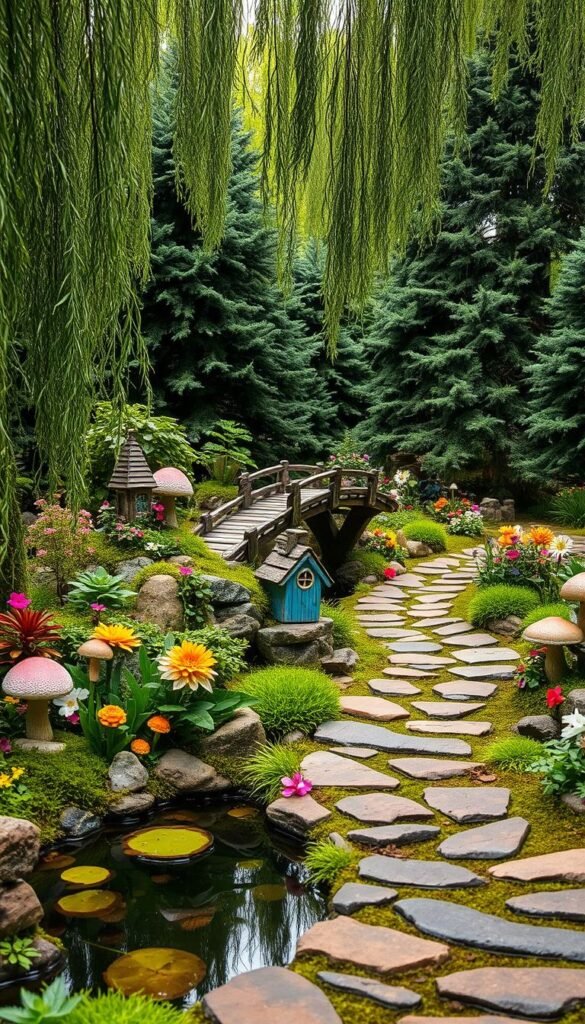
Creating a magical outdoor area begins with smart design choices that feel effortless. Think of your space as a story unfolding – each turn reveals new delights while maintaining cozy charm.
Planning Your Layout
Start by sketching curved beds that mimic nature’s flow. Repeat clusters of foxgloves or hollyhocks every 8-10 feet to create rhythm. Stick to 3-4 main colors like lavender, butter yellow, and blush pink for harmony.
Try this simple formula for balanced planting:
| Front Layer | Middle Layer | Back Layer |
|---|---|---|
| Thyme | Shasta Daisies | Lilac Bushes |
| Pansies | Peonies | Climbing Roses |
Identifying Focal Points
Anchor your design with showstoppers – a weathered bench under a crabapple tree or a birdbath surrounded by catmint. These elements guide the eye without feeling rigid.
Transition between areas using height variations. Place low-growing herbs near paths, then build upward with medium shrubs before adding tall flowering trees. This layered look keeps visitors curious about what’s around the bend.
Selecting the Perfect Plants for Your Cottage Garden
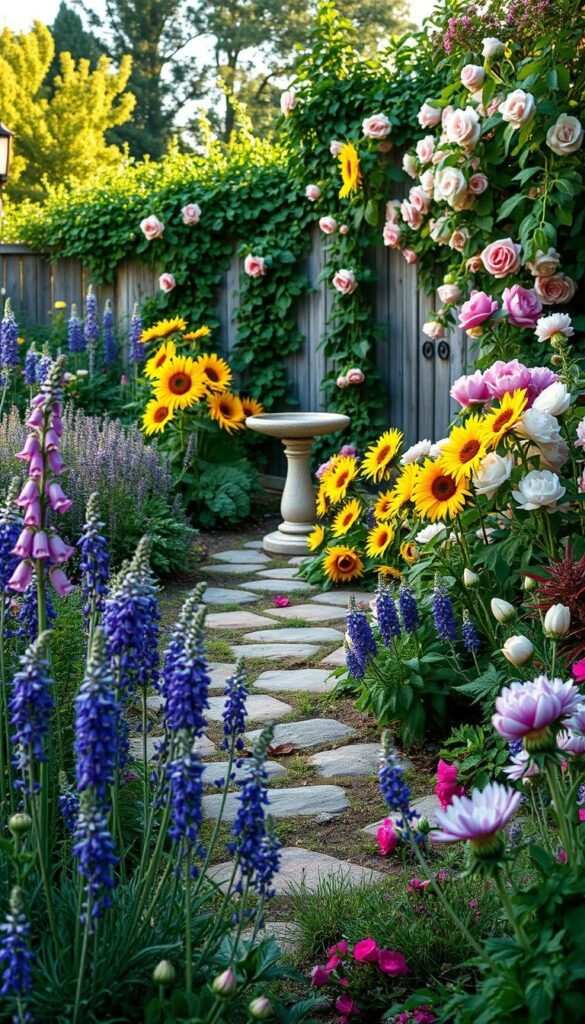
Your plant choices breathe life into every corner of your outdoor sanctuary. Mix heirloom treasures with easy-care performers to create depth and romance. Let’s explore how to combine these elements for year-round charm.
Timeless Blooms That Keep Giving
Antique roses form the heart of your design, offering fragrance and history. The blush-pink ‘Great Maiden’s Blush’ (dating to the 1400s) fills air with pure rose scent, while ‘Reine des Violettes’ stuns with lilac-purple blooms.
| Plant Type | Examples | Bloom Period | Key Benefit |
|---|---|---|---|
| Perennials | Foxgloves, Peonies | Spring-Fall | Yearly return |
| Annuals | Zinnias, Sweet Peas | Summer | Color bursts |
| Heirlooms | Rosa ‘Madame Calvat’ | Late Spring | Historic charm |
Vertical Magic With Living Curtains
Train climbing vines to transform plain structures. Pair ‘Cecile Brunner’ roses with clematis for layered textures. Jasmine and honeysuckle add evening fragrance, turning arbors into scented gateways.
Choose plants that spill over edges and attract butterflies. This relaxed approach creates that coveted “lived-in” look while supporting local ecosystems.
Your Step-by-Step Backyard Cottage Garden Makeover: From Plain Yard to Fairy-Tale Escape
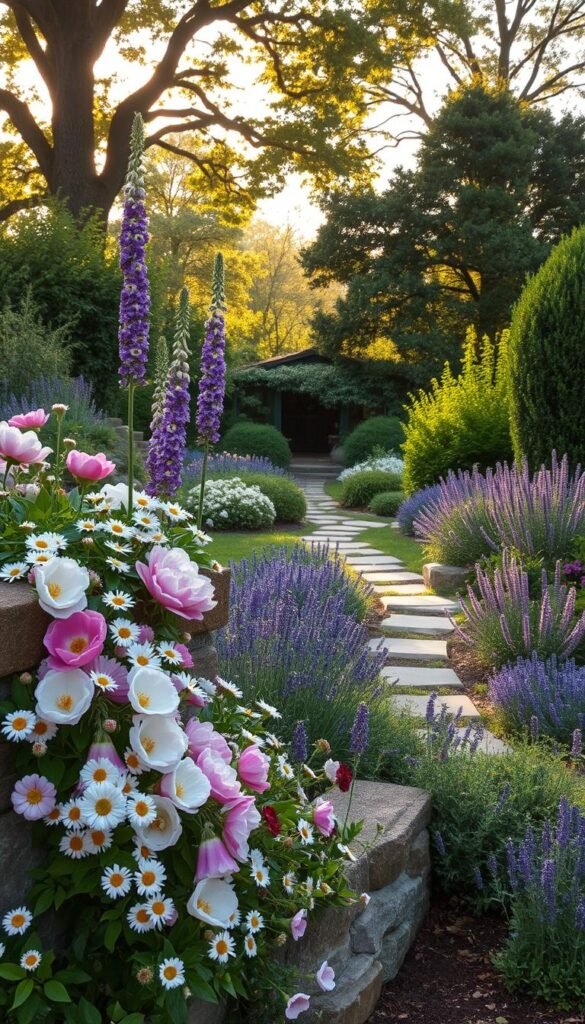
Transform your outdoor space into a living tapestry using nature’s own playbook. Start by building three-dimensional depth through strategic plant layers that support pollinators and create visual harmony.
First, choose native trees like dogwoods or redbuds for height and shade. These form your garden’s “ceiling,” sheltering birds and filtering sunlight. Underplant with berry-producing shrubs—viburnums or elderberries—to bridge vertical space and feed wildlife.
Next, let lower-growing plants weave magic at eye level. Combine feathery cosmos with spiky lupines and mounding catmint. As Piet Oudolf, the legendary garden designer, advises:
“Let plants dance together—their movement tells the story.”
Allow blooms to spill onto walkways and tumble over stone walls. This softens edges and creates that coveted effortless charm. Use this simple guide to balance structure and spontaneity:
| Plant Layer | Examples | Function |
|---|---|---|
| Upper | Crabapple trees | Create shade & height |
| Middle | Hydrangeas, Roses | Add seasonal color |
| Lower | Lavender, Columbine | Fill gaps & attract bees |
Time your planting for success. Early spring works best for perennials, while fall is ideal for bulbs like tulips and daffodils. Remember—your space should evolve like a good novel, with each chapter revealing new surprises.
Creating Winding Pathways and Rustic Accents
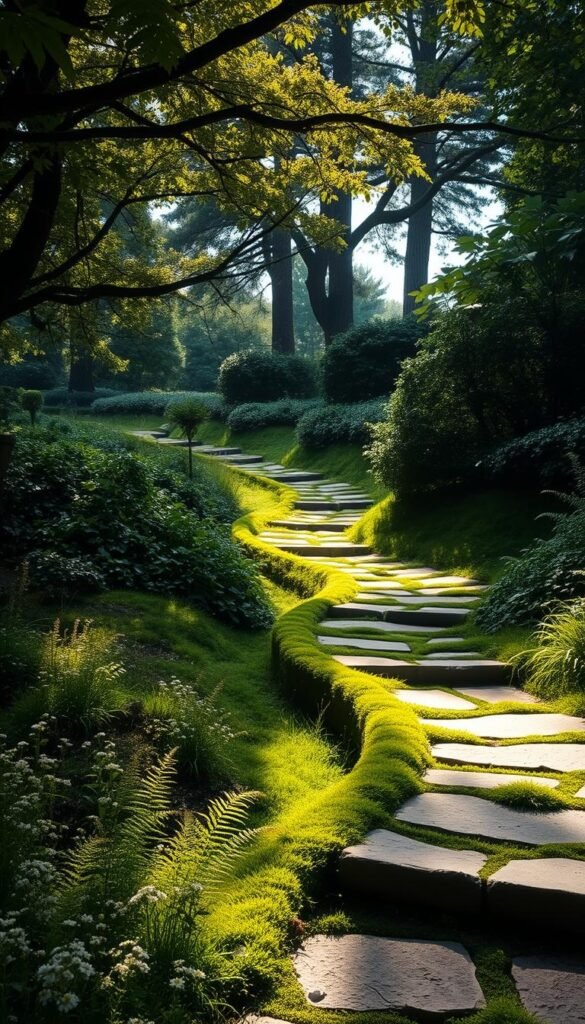
Curving walkways invite exploration while shaping your landscape’s personality. These pathways act as nature’s red carpet, leading visitors through floral vignettes and secret seating areas.
Natural Stone and Gravel Options
Choose materials that age gracefully. Irregular flagstones create timeless charm, while gravel adds crunch underfoot. Mix textures for visual intrigue:
| Material | Best Use | Maintenance |
|---|---|---|
| Limestone | Main paths | Low |
| Decomposed granite | Secondary trails | Moderate |
| Reclaimed brick | Edging/accents | High |
For eco-friendly solutions, try permeable options like crushed shells or pea gravel. These allow rainwater to nourish nearby plants while preventing puddles.
Enhancing with Moss and Organic Curves
Let nature soften your design. Encourage moss growth between stones by keeping areas slightly damp. This living carpet adds centuries-old character in just a few seasons.
Create flowing lines that mirror nearby flower beds. A gentle S-curve makes small spaces feel larger, while wide arcs showcase showstopping plant combinations. Vary path widths—3 feet for main routes, 18 inches for intimate detours.
Finish with edging plants that spill onto walkways. Sweet woodruff or creeping thyme release fragrance when brushed against, turning every stroll into a sensory experience.
Layering Your Garden with Textural Interest
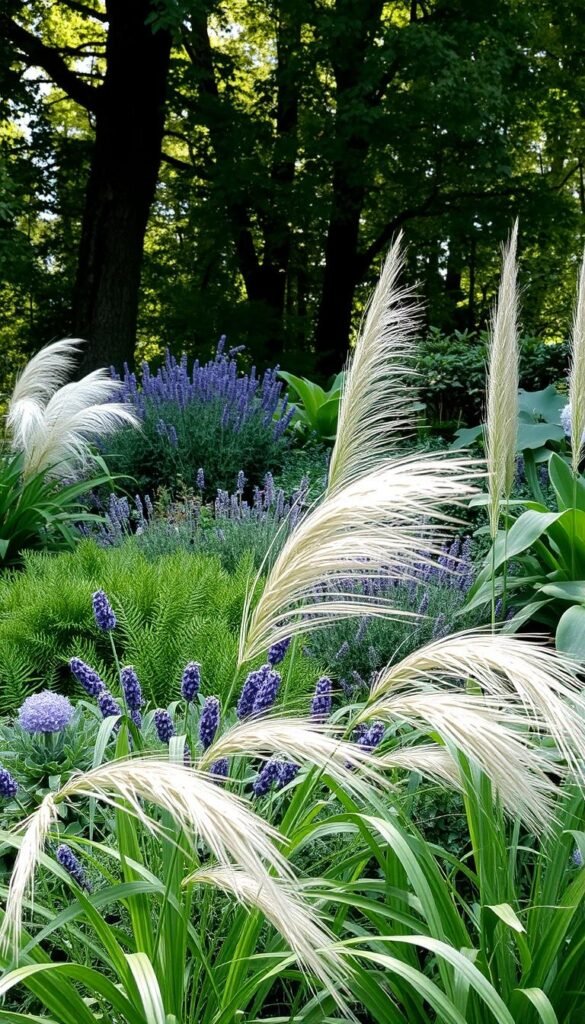
Build depth and character by treating your space like a living sculpture. Structural elements form the foundation, while contrasting foliage adds drama at every turn.
Trees, Shrubs, and Groundcovers
Start with tall specimens that shape your canvas. Serviceberry trees offer spring blossoms and winter bark patterns, while dwarf apple varieties provide four-season appeal. These vertical anchors create natural ceilings for seating areas.
Mid-height shrubs like oakleaf hydrangea fill gaps with summer blooms and fall color. For winter structure, try boxwood hedges or juniper cones. Their evergreen forms keep your design cohesive when flowering plants sleep.
Ground-level textures tie everything together. Sweet woodruff forms starry carpets in shade, while creeping thyme releases fragrance when brushed. These living mats work beautifully in patio container gardening or sprawling beds.
| Plant | Foliage Type | Contrast Pairing |
|---|---|---|
| Lamb’s Ear | Silver Velvet | Purple Sage |
| Japanese Maple | Lacy Red | Hosta |
| Fern | Feathery Green | Heuchera |
Mix leaf shapes for visual punch. Pair spiky yucca with round hydrangea leaves, or let airy ferns soften stone pathways. This interplay keeps eyes moving through your composition.
Enhancing the Garden with Fragrant Flowers and Herbs
A garden that delights the nose becomes a place you never want to leave. Fragrant plants add invisible magic to your landscape, turning visual beauty into a full-body experience that lingers in memory.
Nature’s Perfume Collection
Lavender works overtime in your space—its silvery foliage brightens borders while purple blooms release calming scents. Evening performers like gardenias and night-blooming jasmine intensify their aroma at dusk, creating romantic moments under twilight skies.
Peonies offer double rewards with lush petals and honey-like fragrance. Cluster phlox near seating areas where its sweet scent can drift through summer breezes. These flowers don’t just please people—they’re pollinator magnets too.
Flavorful Foliage With Style
The mint family brings peppermint stripes and chocolate-scented leaves to your herb beds. Purple sage adds smoky flavor to dishes while sporting violet blooms that hummingbirds adore. Rosemary’s needle-like leaves release piney notes when brushed, perfect for framing pathways.
Time your plantings for nonstop fragrance. Early spring lilacs give way to summer roses, followed by autumn-blooming tea olives. This layered approach ensures every visit offers new sensory surprises.

